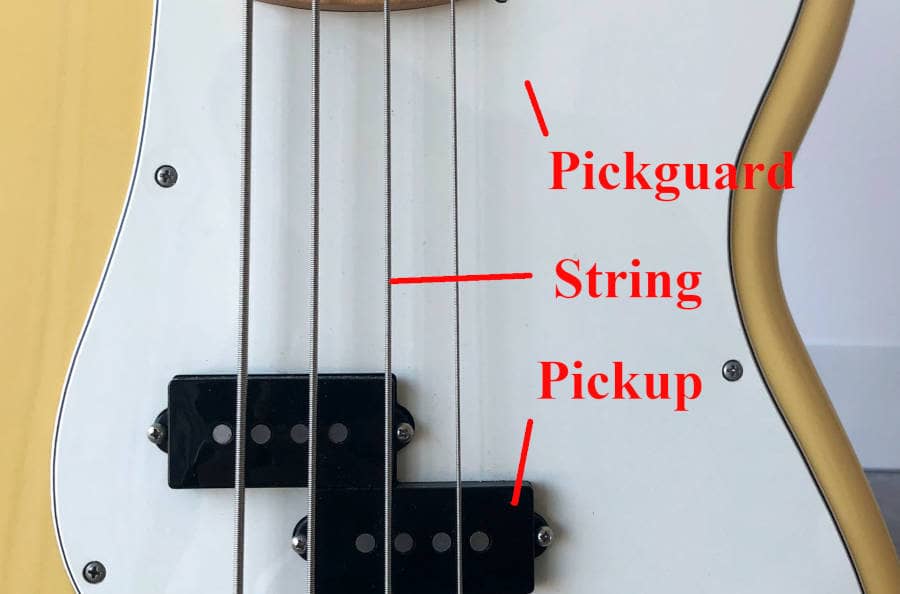Knowing the different parts of a bass guitar is crucial for bassists of all skill levels.
First of all, it helps you identify what makes a bass suit your style and physiology. In the same vein, it also makes it easier to understand why some basses feel cumbersome and slow.
Second, it makes it easier to talk to others about your instrument. This is helpful when discussing the bass with bass players, musicians, and luthiers, or when giving or taking lessons.
Therefore, I`ve written this list of every part of the bass guitar. I`ve highlighted what they look like, what they do, and how they can impact the sound, look, and feel of the bass as a whole.
This came out to 21 parts in total. Thus, I also made an infographic that will make it easier to remember all of the parts after reading.
1. Headstock
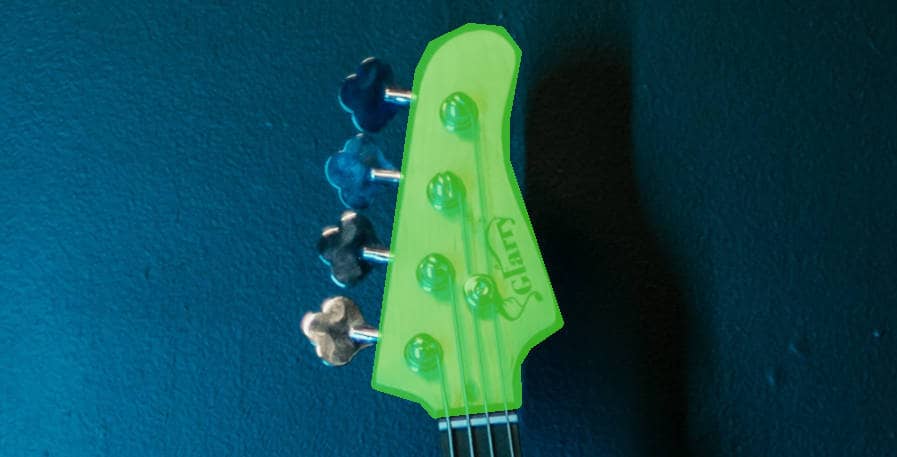
The headstock makes up the entire upper part of the bass guitar and houses many other components.
By being fastened to the headstock, strings are able to hold tension, which is needed for them to produce discernable pitches and be playable. The headstock also provides a counterweight to the body of the bass, which keeps it balanced and thus easier to play.
There are headless bass guitars, and headstocks are thus not a strict necessity for a bass.
However, headstocks make tuning and staying in tune convenient. Since the bass` guitars rise to popularity in the 50s, headstocks have also become an integral part of the look of the bass guitar.
2. Tuning Posts
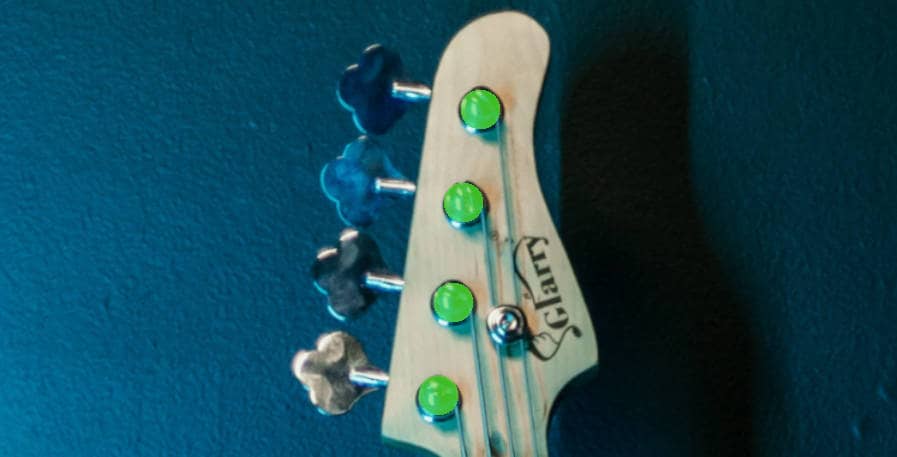
On the headstocks, the strings are fastened to and wrapped around the tuning posts. These are also sometimes called string posts, or string pegs.
There is an individual post for each string of the bass, and they ensure that the strings are fastened securely to the headstock.
In the tuning post, the tip of the string is fastened into a small hole and then wrapped around it.
Generally, how many times strings should wrap around tuning pegs dictates how bassists cut their strings. It is common to wrap strings 2-3 times around them. In some cases, such as with the Fender Precision, certain strings need to be wrapped as many as 4-5 times.
3. String Tree
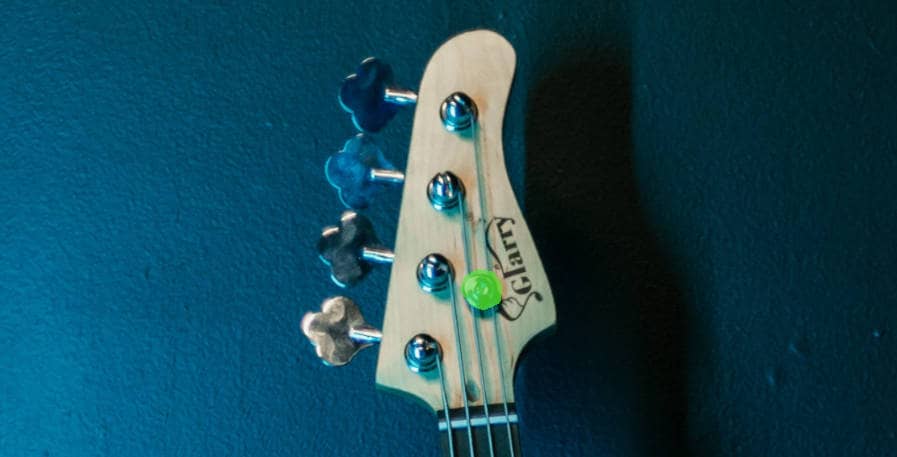
String trees, sometimes called string guides or string retainers, are used to secure certain strings in place between the end of the neck and the string posts.
If the distance between the neck and post is too long, the string`s break angle will not be steep enough. This results in the string not being secured properly, which can reduce the sustain and resonance of the string. It can also cause the bass guitar to rattle.
It is thus most common for string trees to secure the strings that are furthest up on the headstock. This is because these strings will have the least steep break angle due to them needing to reach further.
In the image above the string tree is securing are the D and G strings for this reason. For basses with two tuning pegs on each side of the headstock, it would secure the A and D string instead.
4. Tuning Pegs
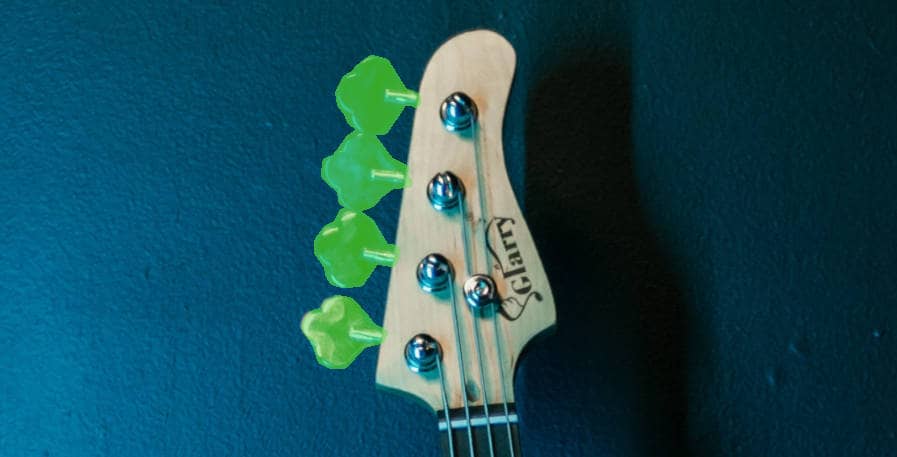
It is the tuning pegs, also called tuning keys, that make it possible to tune a bass guitar.
Thus, when stringing a bass, or when it goes out of tune,the tuning pegs are used to retune the bass.
They are also used to change the tuning of bass guitars. This is common in metal and hard rock, where bass players use different tunings to attain a heavier and deeper sound.
5. Nut
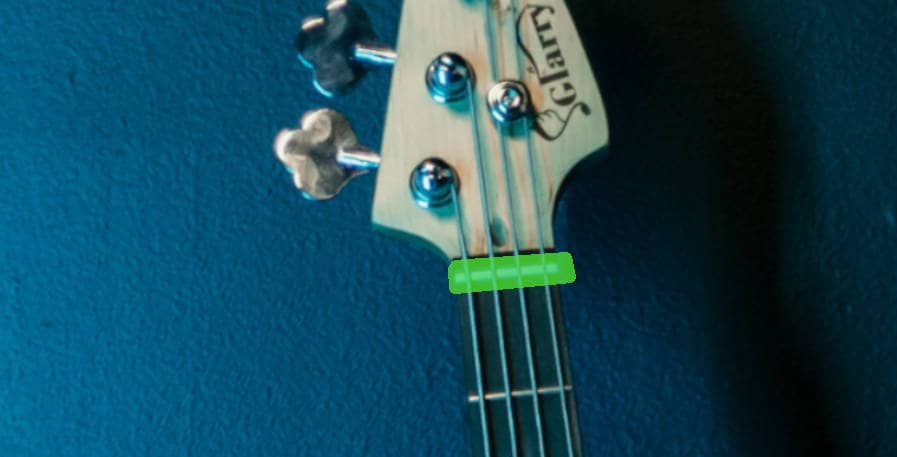
The nut holds the strings in place where the neck ends and the headstock begins.
The cuts in the nut dictate how wide apart the strings on your bass are. Thus, switching to a nut with a different width between the cuts can completely alter how your instrument feels to play.
Furthermore, when the height of a bass nut is set improperly, it will negatively impact how the bass sounds and feels to play.
If it is too high, the action of the bass rises, which makes it harder to fret strings. This can also cause intonation issues, meaning the bass won`t sound consistently in tune across the neck.
If the nut height is too low the strings will make contact with the frets, which will result in the bass producing a humming sound.
6. Neck
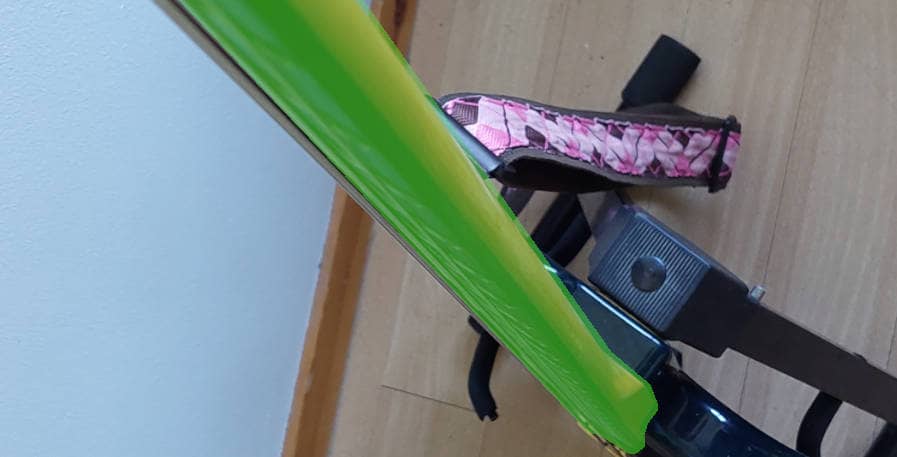
The neck makes up the middle parts of a bass. It is connected to the body and ends at the nut where the headstock begins.
The width, thickness, and build material of a neck are some of the most important factors for how a bass feels to play.
For example, Fender Precision basses have thick necks, which can make them feel less suitable for bassists with small hands. On the other hand, the Fender Jazz Bass has a slimmer neck, which can make it a more suitable instrument.
Some bassists also take steps to make the neck of their bass faster to play. There are also many stories of bassists switching out the necks of their basses to a more preferred one.
7. Fretboard
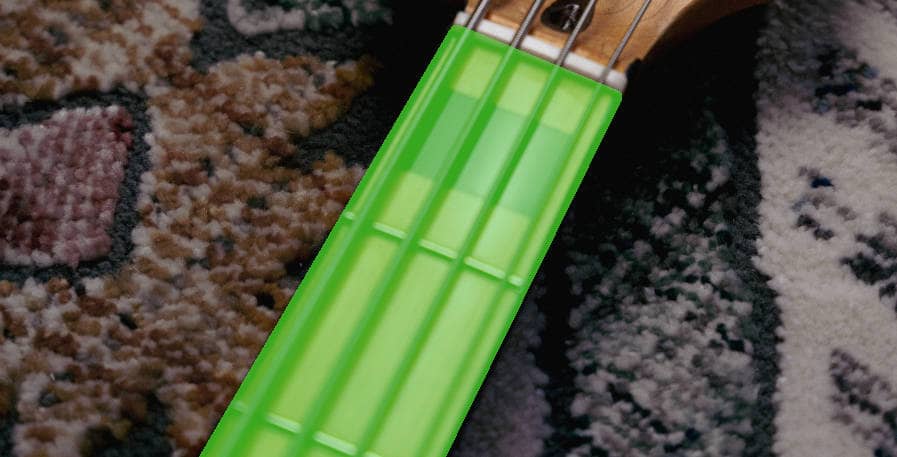
The fretboard of a bass is the playable surface area of its neck. It is here that you will be using your non-dominant hand to fret strings to change the pitch of the instrument.
As it is the most important part of the neck, it has a big impact on the playability of a bass.
The radius and width of the fretboard are crucial dimensions of a bass guitar that can make a fretboard feel difficult or smooth to play. Thus, the importance of having a neck that suits your style is closely related to how the fretboard feels to play.
8. Frets
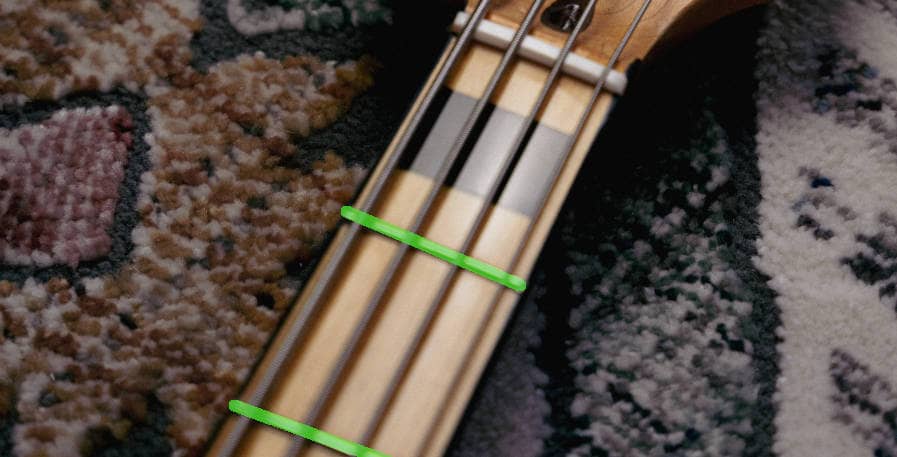
The purpose of frets is to make different notes on the bass discernable in pitch. Playing the E string on the first fret produces an F, playing the same string on the second fret produces an F#, and so on. Most bass guitars have 20-24 frets.
Thus, as long as a bass is tuned correctly, frets ensure that you are always playing notes that are part of the chromatic scale.
There are also fretless basses. However, the lack of frets makes it harder to play in tune and requires more precision in how you fret strings. As a result, starting out on a fretless bass is more challenging than starting with a fretted one.
9. Fret Markers
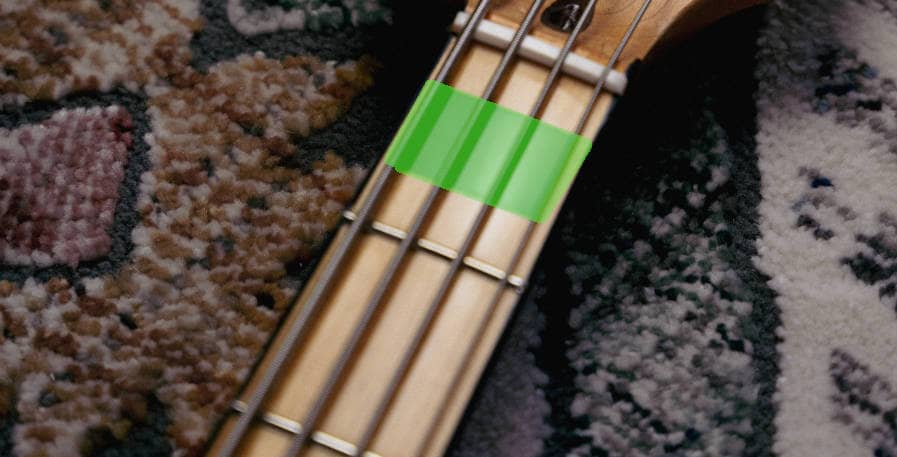
Fret markers make it easier to locate the notes you want to play on the fretboard.
For example, they prevent scenarios where you have to second guess whether you are playing at the 6th or 7th fret. Instead, you can know from the fret markers exactly where you are, and thus prevent mistakes in your playing.
These markers are commonly located at the 3rd, 5th, 9th, and 12th fret. This pattern repeats at the higher parts of the neck, as they are also found on the 15th, 17th, 19th, 21st, and 24th frets. The 12th and 24th frets are generally marked differently, to indicate that they are octaves.
In the photo of a fender jazz bass above, there is also a marker on the 1st fret. Furthermore, while this bass has thick lines as fret markers, it’s most common for basses to have small dots instead.
Fret markers are not a strict necessity and some basses do not have them. However, they do make playing the bass easier, especially so for beginners.
10. Strings
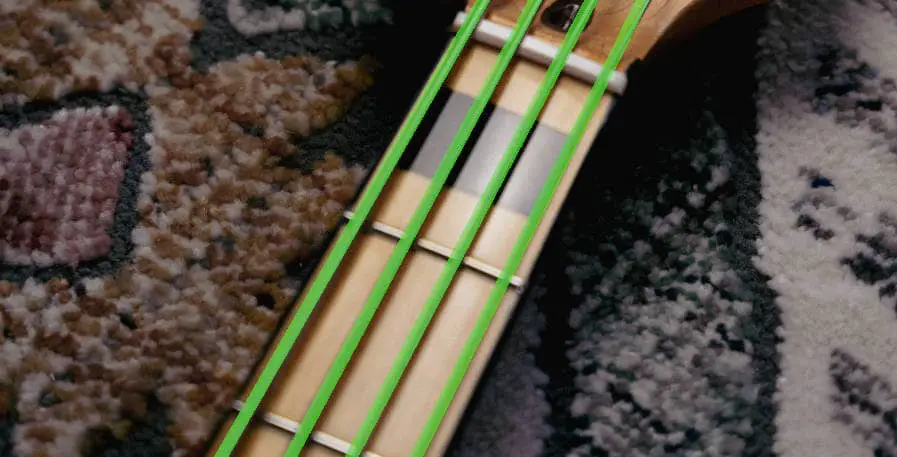
Basses commonly have 4 strings, and it is the vibration of the strings that make a bass able to produce sounds. They are strung to hold enough tension to produce deep pitches while still being loose enough to vibrate freely.
Differences in string winding can completely alter the sound of a bass. Roundwound strings are commonplace in metal and punk but tend to lend themselves poorly to genres like jazz. On the other hand, flatwounds are perfect for attaining a musky tone that is essential for smooth and slower songs.
String gauge also affects both the tone and playability of a bass. Thicker strings are more demanding to pluck and have a dark and resonant tone. Thinner strings are less demanding to pluck and have a sharper and brighter tone than thicker ones.
11. Truss Rod
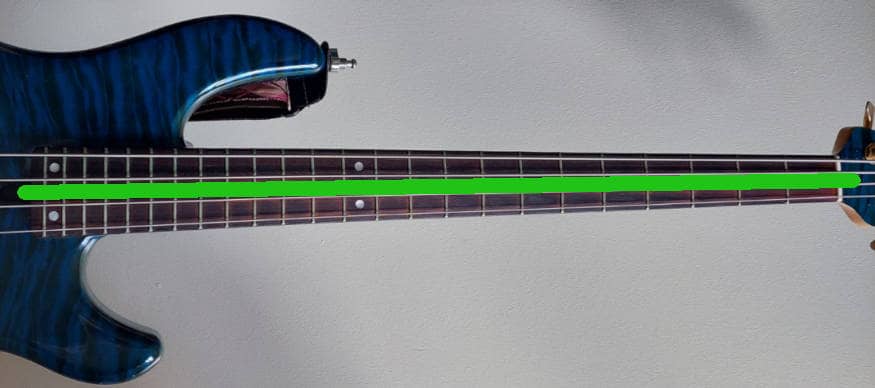
The truss rod is located inside the neck of the bass. Its function is to provide counter tension to the strung strings on the bass.
This is because, without it, the tension of the strings would make the neck of the bass contort out of shape. Therefore, a bass would also become damaged and unplayable without the truss rod holding it together.
Sometimes, the truss rod needs to be adjusted to change how much the neck is bending. Generally, this is done when setting up a bass, or when lowering the action on it.
12. Body
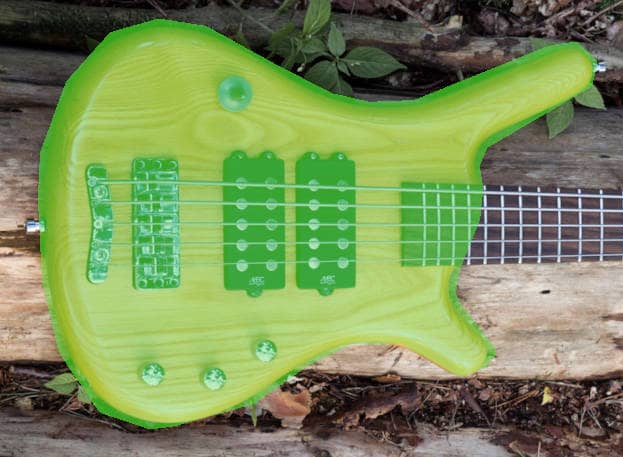
The body is the lowest main part of a bass guitar and it houses several other key components.
Both the material and the shape of it change how a bass sounds. When made out of denser types of wood, the bass tends to sound more resonant. As these types of wood tend to be more costly, expensive bass guitars generally sound better than cheap ones.
The shape of the body also dictates how comfortable a bass feels to play for longer periods of time. If it does not rest naturally against your body, or it is too heavy, this can make practice sessions and gigs feel cumbersome.
13. Strap buttons
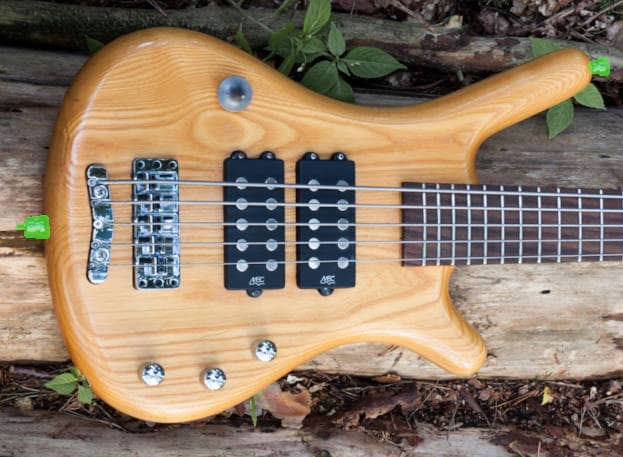
Bass straps are fastened to the strap buttons on a bass. Some also refer to strap buttons as strap posts. In general, these are located at the lowest and highest points of the body.
In some casses, bassists elect to move the posistion of the strap posts to the fix neck dive on a bass.
Most of the time though, they are not something bass players pay much attention to. This is because they tend to be placed so that the bass remains balanced when it is strapped onto you. The height of your bass strap is also adjusted on the strap itself, and not through the help of the strap buttons.
14. Knobs
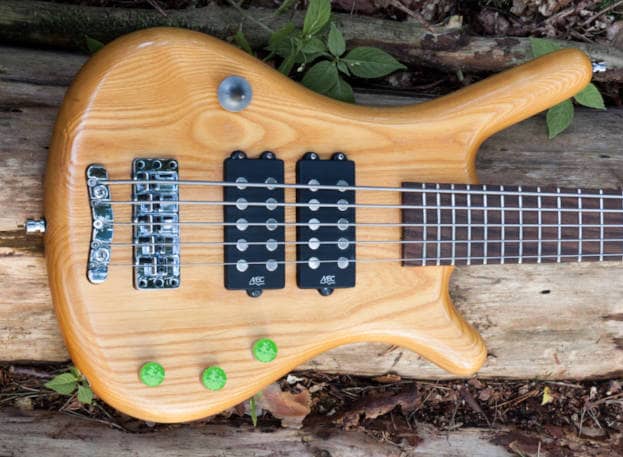
The knobs on a bass guitar are used to adjust the volume, tone, and pickup selection on a bass guitar.
Some basses have more knobs than others. At the very least, they all have a master volume knob and a tone knob that adjusts the treble.
Active basses with 2 pickups tend to have a knob to control the volume of each pickup or one knob that adjusts the balance between the two. The neck pickup can be turned up to get a smoother tone. Bridge pickups on, the other hand, can be turned up to get a sharper tone.
Some basses also have knobs that further control the EQ of the bass, and can be used to adjust the mid and low frequencies. To learn more, check out my guide on what the knobs on a bass guitar do.
15. Pickups
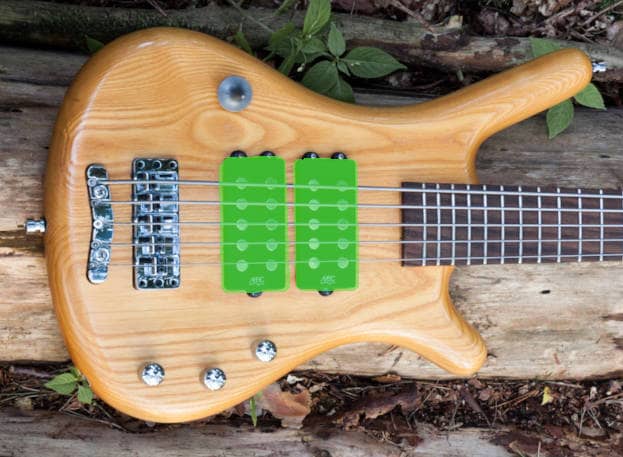
The pickups pick up the vibrations of the bass strings. Then, they change the vibrations they pick up into electrical energy.
In order for the instrument cable to transfer this signal from the bass guitar to an amp, it needs to be picked up first. This is done by the pickups, and without them, there would be no signal to send to an amplifier.
What type of signal the pickups pick up varies on where they are placed on the body and on the build of the pickups themselves.
For example, the difference between pickups in J and P basses, is that the Jazz bass has two single-coil pickups, whereas the Precision bass has a split-coil pickup. These pick up the signal in different ways and is a big part of what gives the instruments their signature sounds.
Furthermore, neck pickups and bridge pickups sound different due to where they are placed on the body. Bridge pickups tend to have a brighter and sharper tone, whereas neck pickups are smoother and darker.
16. Bridge Saddles
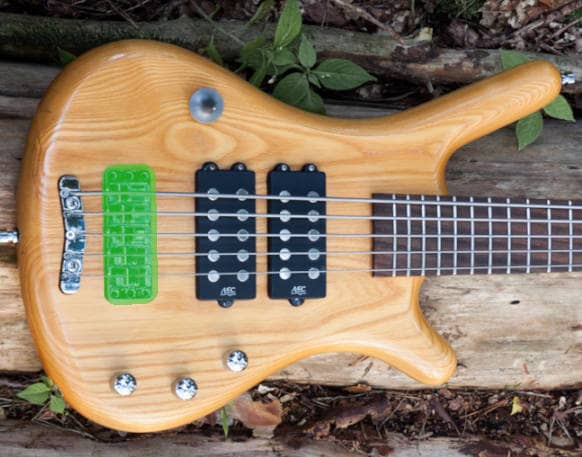
The bridge saddles anchor the strings in place and determine their height and spacing. Thus, the bridge saddles serve a similar function on the body as the nut does on the headstock.
The material and quality of the bridge saddles are not crucial for the sound of your bass. However, how the bridge saddles are set up can make or break how a bass feels to play.
If the strings are raised too high this will lead to high action which makes strings harder to fret. As mentioned above, this can also lead to a range of other issues.
17. Bridge
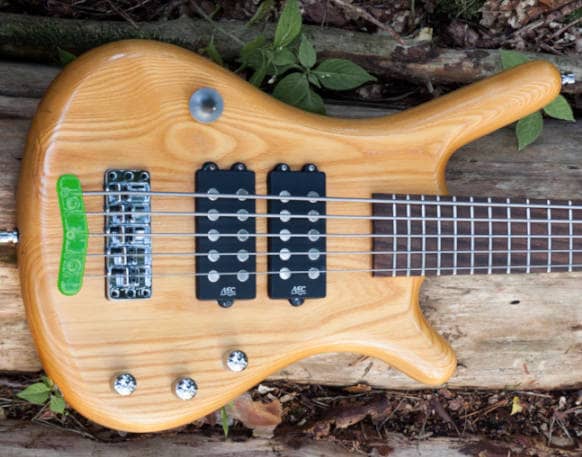
Similar to the tuning posts on the headstocks, the bridge keeps the strings anchored to the body of the bass. When stringing a bass, strings are weaved through small holes in the bridge before being strung to the tuning posts.
In the photos above the bridge and bridge saddles are two separate parts. However, on many basses, you will find that they are connected and that the bridge saddles are situated on the bridge itself.
18. Pickguard
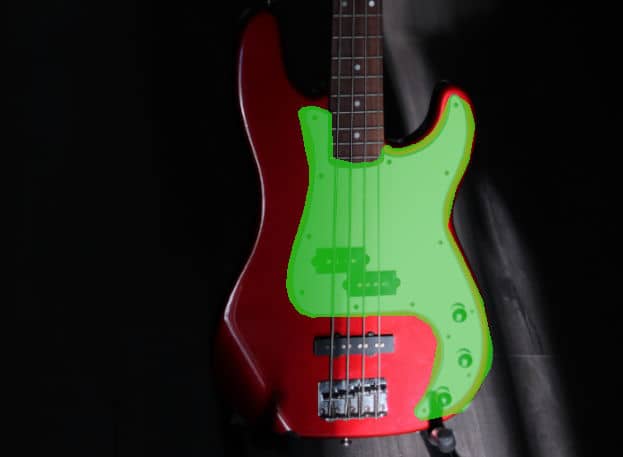
There are two main reasons basses have pickguards.
The first is to serve as a layer of protection so that you don`t ruin the finish of the bass when you pick against it. The second is that it greatly impacts the look of the bass, and makes for an aesthetic that many prefer.
Thus, pickguards are not an essential part of the bass guitar. Aside from their looks, they are redundant if you slap the bass, or pluck it with your fingers.
Also, when playing the bass with a pick you should ideally not be hitting the body of the bass. In case this happens though, pickguards ensure that you don`t ruin the finish on your bass.
19. Pickup Cover
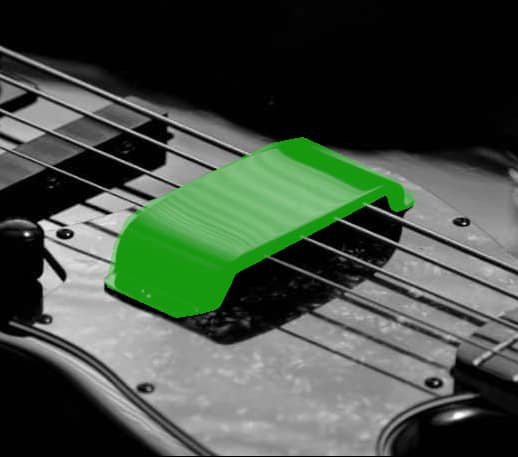
While they used to be commonplace when Leo Fender introduced the bass guitar in the 1950s, most basses don`t have pickup covers nowadays. Furthermore, it is a common practice for bass players to remove them from basses that do.
However, some bassists prefer pickup covers. Common reasons for this are that they like to rest their thumb on it, that they claim it improves the sound, or that they simply like the look of it.
Initially, they were meant to shield the pickups from interfering frequencies. In modern times though, this has been debunked and pickup covers do not actually provide any meaningful shielding from outside signals.
20. Jack Output
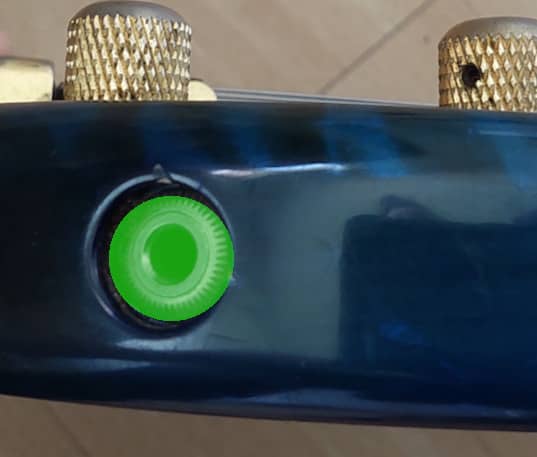
The jack input is used to connect the bass with an amplifier.
Through it, an instrument cable gets connected to the electronics inside the bass. Thus, it serves as a convenient way to quickly plug in and play the bass.
Without it, the bass can purely be played acoustically. Thus, despite being a small part the jack output is an essential component for the bass to be playable.
21. Cavity
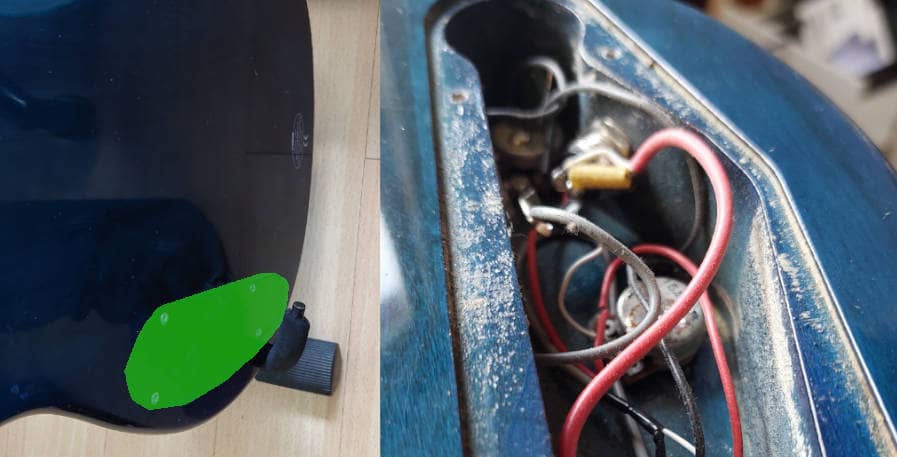
The cavity is found on the backside of the body of a bass guitar.
It houses the electronics that are essential for a bass to be playable. They make it possible for the signal that your pickups pick up to be transferred out of the jack output and to travel to an amplifier. These electronics are also what make the pickups and tone knobs do anything.
On some basses, you will have an additional smaller cavity. This means you have an active bass that uses a battery, which is housed in the smaller cavity.
This is helpful to know, as bass batteries generally last 6-12 months. Thus, if your bass diminishes in sound til it is no longer able to produce an amplified signal, this is likely due to the battery needing to be changed.
Conclusion
And that`s every part of a bass guitar. All bass guitars have most of these parts, and could not be played without them. Some parts, such as the pickguard and pickup cover that are not essential for the bass to be playable, will be found on some basses but not others.
I know this is a lot to remember, so to help you out, I also made an infographic. Feel free to pin it, print it out, save it, or use it however you like to better remember the different parts of the bass.
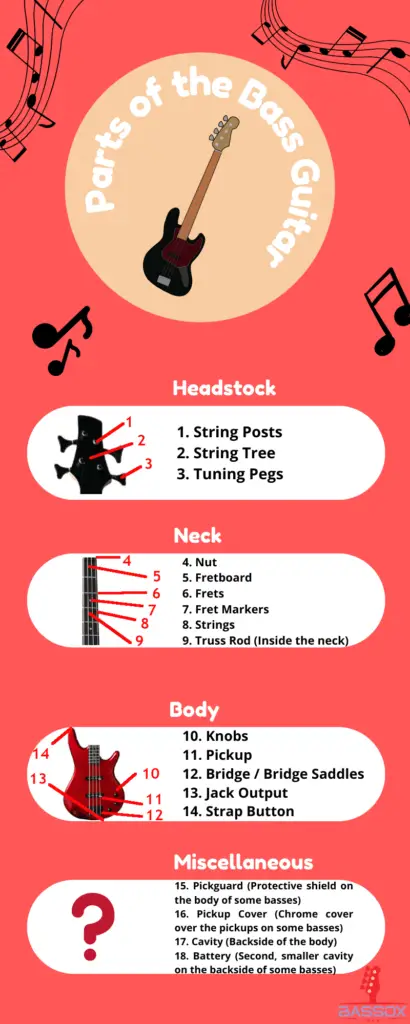
Lastly, by putting in the effort to memorize all of these parts you are doing yourself a big favor. This is because it will help you develop a better understanding of your instrument. It will also make it easier to ask better questions about the bass, which will lead to better answers.
It will also assist in identifying what makes a bass suit you or not. When you understand that you like the neck of a bass, but not the pickups, you are one step closer to knowing what your dream bass is like.

